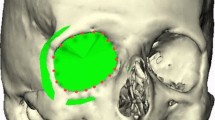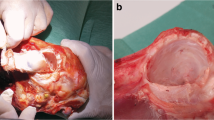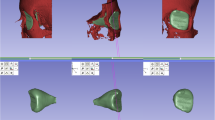Abstract
Purpose
Objective determination of the orbital volume is important in the diagnostic process and in evaluating the efficacy of medical and/or surgical treatment of orbital diseases. Tools designed to measure orbital volume with computed tomography (CT) often cannot be used with cone beam CT (CBCT) because of inferior tissue representation, although CBCT has the benefit of greater availability and lower patient radiation exposure. Therefore, a model-based segmentation technique is presented as a new method for measuring orbital volume and compared to alternative techniques.
Methods
Both eyes from thirty subjects with no known orbital pathology who had undergone CBCT as a part of routine care were evaluated (\(n = 60\) eyes). Orbital volume was measured with manual, atlas-based, and model-based segmentation methods. Volume measurements, volume determination time, and usability were compared between the three methods. Differences in means were tested for statistical significance using two-tailed Student’s t tests.
Results
Neither atlas-based \((26.63 \pm 3.15\,\hbox {mm}^{3})\) nor model-based \((26.87 \pm 2.99\,\hbox {mm}^{3})\) measurements were significantly different from manual volume measurements \((26.65 \pm 4.0\,\hbox {mm}^{3})\). However, the time required to determine orbital volume was significantly longer for manual measurements (\(10.24 \pm 1.21\) min) than for atlas-based (\(6.96 \pm 2.62\) min, \(p < 0.001\)) or model-based (\(5.73 \pm 1.12\) min, \(p < 0.001\)) measurements.
Conclusion
All three orbital volume measurement methods examined can accurately measure orbital volume, although atlas-based and model-based methods seem to be more user-friendly and less time-consuming. The new model-based technique achieves fully automated segmentation results, whereas all atlas-based segmentations at least required manipulations to the anterior closing. Additionally, model-based segmentation can provide reliable orbital volume measurements when CT image quality is poor.







Similar content being viewed by others
References
Oppenheimer AJ, Monson LA, Buchman SR (2013) Pediatric orbital fractures. Craniomaxillofac Trauma Reconstr 6(1):9–20. doi:10.1055/s-0032-1332213
Fadda MT, Saverio De Ponte F, Bottini DJ, Iannetti G (1996) Study and planning of the surgical procedure for the orbital district in patients affected by craniofacial malformations. J Craniofac Surg 7(3):207–223
Gellrich NC, Schramm A, Hammer B, Schmelzeisen R (1999) The value of computer aided planning and intraoperative navigation in orbital reconstruction. Int J Oral Maxillofac Surg 28:52–53
Holck DE, Boyd EM Jr, Ng J, Mauffray RO (1999) Benefits of stereolithography in orbital reconstruction. Ophthalmology 106(6):1214–1218. doi:10.1016/S0161-6420(99)90254-3
Curley A, Hatcher DC (2010) Cone beam CT-anatomic assessment and legal issues: the new standards of care. Today’s FDA 22(4):52–55, 57–59, 61–53
Mischkowski RA, Pulsfort R, Ritter L, Neugebauer J, Brochhagen HG, Keeve E, Zoller JE (2007) Geometric accuracy of a newly developed cone-beam device for maxillofacial imaging. Oral Surg Oral Med Oral Pathol Oral Radiol Endod 104(4):551–559. doi:10.1016/j.tripleo.2007.02.021
Wang L, Chen KC, Shi F, Liao S, Li G, Gao Y, Shen SG, Yan J, Lee PK, Chow B, Liu NX, Xia JJ, Shen D (2013) Automated segmentation of CBCT image using spiral CT atlases and convex optimization. Medical image computing and computer-assisted intervention. In: MICCAI international conference on medical image computing and computer-assisted intervention, vol 16(Pt 3), pp 251–258
Charteris DG, Chan CH, Whitehouse RW, Noble JL (1993) Orbital volume measurement in the management of pure blowout fractures of the orbital floor. Br J Ophthalmol 77(2):100–102
Lukats O, Vizkelety T, Markella Z, Maka E, Kiss M, Dobai A, Bujtar P, Szucs A, Barabas J (2012) Measurement of orbital volume after enucleation and orbital implantation. PloS One 7(12):e50333. doi:10.1371/journal.pone.0050333
Regensburg NI, Kok PH, Zonneveld FW, Baldeschi L, Saeed P, Wiersinga WM, Mourits MP (2008) A new and validated CT-based method for the calculation of orbital soft tissue volumes. Invest Ophthalmol Vis Sci 49(5):1758–1762. doi:10.1167/iovs.07-1030
Metzger MC, Bittermann G, Dannenberg L, Schmelzeisen R, Gellrich NC, Hohlweg-Majert B, Scheifele C (2013) Design and development of a virtual anatomic atlas of the human skull for automatic segmentation in computer-assisted surgery, preoperative planning, and navigation. Int J Comput Assist Radiol Surg 8(5):691–702. doi:10.1007/s11548-013-0818-6
Smith DM, Oliker A, Carter CR, Kirov M, McCarthy JG, Cutting CB (2007) A virtual reality atlas of craniofacial anatomy. Plast Reconstr Surg 120(6):1641–1646. doi:10.1097/01.prs.0000282452.22620.25
Cohen LD (1991) On active contour models and balloons. CVGIP Image Underst 53(2):211–218
McInerney T, Terzopoulos D (1996) Deformable models in medical image analysis: a survey. Med Image Anal 1(2):91–108
Cootes T, Hill A, Taylor C, Haslam J (1994) Use of active shape models for locating structures in medical images. Image Vis Comput 12(6):355–365
Heimann T, Meinzer HP (2009) Statistical shape models for 3D medical image segmentation: a review. Med Image Anal 13(4):543–563. doi:10.1016/j.media.2009.05.004
Lamecker H, Kamer L, Wittmers A, Zachow S, Kaup T, Schramm A, et al (2007) A method for the three-dimensional statistical shape analysis of the bony orbit. In: Freysinger W, Weber S, Caversaccio M (eds) Computer aided surgery around the head: 4th international CAS-H conference proceedings, Pro Business, Berlin, pp 94–97
Becker M, Magnenat-Thalmann N (2014) Deformable models in medical image segmentation. Springer, Berlin
Deserno TM (2011) Biomedical image processing. Springer Science & Business Media, Berlin
Ecabert O, Peters J, Weese J (2006) Modeling shape variability for full heart segmentation in cardiac computed-tomography images. In: Medical imaging, 2006. International Society for Optics and Photonics, pp 61443R–61443R-61412
Zheng Y, Barbu A, Georgescu B, Scheuering M, Comaniciu D (2008) Four-chamber heart modeling and automatic segmentation for 3-D cardiac CT volumes using marginal space learning and steerable features. IEEE Trans Med Imaging 27(11):1668–1681
Zhu Z, Li G (2011) Construction of 3D human distal femoral surface models using a 3D statistical deformable model. J Biomech 44(13):2362–2368. doi:10.1016/j.jbiomech.2011.07.006
Heimann T, Meinzer HP, Wolf I (2007) A statistical deformable model for the segmentation of liver CT volumes. In: Heimann T, Styner M, van Ginneken B (eds) MICCAI 2007 workshop proceedings: 3D segmentation in the clinic—a grand challenge, pp 161–166
Yushkevich PA, Piven J, Hazlett HC, Smith RG, Ho S, Gee JC, Gerig G (2006) User-guided 3D active contour segmentation of anatomical structures: significantly improved efficiency and reliability. NeuroImage 31(3):1116–1128. doi:10.1016/j.neuroimage.2006.01.015
Nyström I, Nysjö J, Malmberg F (2011) Visualization and haptics for interactive medical image analysis: Image segmentation in cranio-maxillofacial surgery planning. In: Badioze Zaman H et al (eds) Visual informatics: sustaining research and innovations. IVIC 2011, Part I. LNCS 7066. Springer, Berlin, pp 1–12
Becker M, Friese KI, Wolter FE, Gellrich NC, Essig H (2015) Development of a reliable method for orbit segmentation & measuring. In: 2015 IEEE international symposium on medical measurements and applications (MeMeA), accepted May 2015
Friese KI, Blanke P, Wolter FE (2011) YaDiV–an open platform for 3D visualization and 3D segmentation of medical data. Vis Comput 27(2):129–139
Bite U, Jackson IT, Forbes GS, Gehring DG (1985) Orbital volume measurements in enophthalmos using three-dimensional CT imaging. Plast Reconstr Surg 75(4):502–508
Schuknecht B, Carls F, Valavanis A, Sailer HF (1996) CT assessment of orbital volume in late post-traumatic enophthalmos. Neuroradiology 38(5):470–475
Ploder O, Klug C, Voracek M, Burggasser G, Czerny C (2002) Evaluation of computer-based area and volume measurement from coronal computed tomography scans in isolated blowout fractures of the orbital floor. J Oral Maxillofac Surg 60(11):1267–1272 discussion 1273–1264
Scolozzi P, Jaques B (2008) Computer-aided volume measurement of posttraumatic orbits reconstructed with AO titanium mesh plates: accuracy and reliability. Ophthalmic Plast Reconstr Surg 24(5):383–389. doi:10.1097/IOP.0b013e318185a72c
Lutzemberger L, Salvetti O (1998) Volumetric analysis of CT orbital images. Med Biol Eng Comput 36(6):661–666
Comerci M, Elefante A, Strianese D, Senese R, Bonavolonta P, Alfano B, Bonavolonta B, Brunetti A (2013) Semiautomatic regional segmentation to measure orbital fat volumes in thyroid-associated ophthalmopathy. A validation study. Neuroradiol J 26(4):373–379
Bentley RP, Sgouros S, Natarajan K, Dover MS, Hockley AD (2002) Changes in orbital volume during childhood in cases of craniosynostosis. J Neurosurg 96(4):747–754. doi:10.3171/jns.2002.96.4.0747
Festa F, Pagnoni M, Valerio R, Rodolfino D, Saccucci M, d’Attilio M, Caputi S, Iannetti G (2012) Orbital volume and surface after Le Fort III advancement in syndromic craniosynostosis. J Craniofac Surg 23(3):789–792. doi:10.1097/SCS.0b013e31824dbeec
Fan X, Li J, Zhu J, Li H, Zhang D (2003) Computer-assisted orbital volume measurement in the surgical correction of late enophthalmos caused by blowout fractures. Ophthalmic Plast Reconstr Surg 19(3):207–211
Manson PN, Grivas A, Rosenbaum A, Vannier M, Zinreich J, Iliff N (1986) Studies on enophthalmos: II. The measurement of orbital injuries and their treatment by quantitative computed tomography. Plastic Reconstr Surg 77(2):203–214
Kwon J, Barrera JE, Most SP (2010) Comparative computation of orbital volume from axial and coronal CT using three-dimensional image analysis. Ophthalmic Plastic Reconstr Surg 26(1):26–29. doi:10.1097/IOP.0b013e3181b80c6a
Whitehouse RW, Batterbury M, Jackson A, Noble JL (1994) Prediction of enophthalmos by computed tomography after ’blow out’ orbital fracture. Br J Ophthalmol 78(8):618–620
Schramm H, Ecabert O, Peters J, Philomin V, Weese J (2006) Towards fully automatic object detection and segmentation. In: Medical imaging, 2006. International Society for Optics and Photonics, pp 614402–614402-614410
Zizelmann C, Gellrich NC, Metzger MC, Schoen R, Schmelzeisen R, Schramm A (2007) Computer-assisted reconstruction of orbital floor based on cone beam tomography. Br J Oral Maxillofac Surg 45(1):79–80. doi:10.1016/j.bjoms.2005.06.031
Kolk A, Pautke C, Schott V, Ventrella E, Wiener E, Ploder O, Horch HH, Neff A (2007) Secondary post-traumatic enophthalmos: high-resolution magnetic resonance imaging compared with multislice computed tomography in postoperative orbital volume measurement. J Oral Maxillofac Surg 65(10):1926–1934. doi:10.1016/j.joms.2006.06.269
Li Z, Chui CK, Cai Y, Amrith S, Goh PS, Anderson JH, Teo J, Liu C, Kusuma I, Siow YS, Nowinski WL (2002) Modeling of the Human Orbit from MR Images. In: Paper presented at the anonymous medical image computing and computer-assisted intervention—MICCAI, Tokyo, Japan, Sep 25–28
Acknowledgments
The work of MEHW and JTL is funded, in part, by the German Federal Ministry of Education and Research. This work was funded by AOCMF. The sponsor or funding organization had no role in the design or conduct of this research. MB contributed to this work while working at the Institute for Man-Machine Communication, Leibniz University Hannover, Germany.
Conflict of interest
No author has any conflict of interest to declare.
Author information
Authors and Affiliations
Corresponding author
Rights and permissions
About this article
Cite this article
Wagner, M.E.H., Gellrich, NC., Friese, KI. et al. Model-based segmentation in orbital volume measurement with cone beam computed tomography and evaluation against current concepts. Int J CARS 11, 1–9 (2016). https://doi.org/10.1007/s11548-015-1228-8
Received:
Accepted:
Published:
Issue Date:
DOI: https://doi.org/10.1007/s11548-015-1228-8




